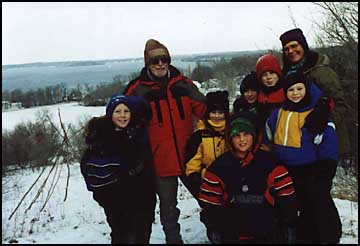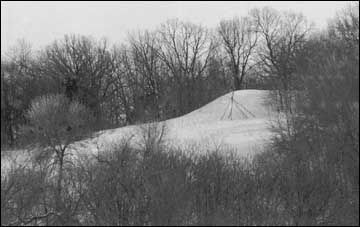 Hahn wants to preserve the mound site for more than researchers. "This is not just about gathering information," she explained. "This is about being and feeling."
Hahn wants to preserve the mound site for more than researchers. "This is not just about gathering information," she explained. "This is about being and feeling." One of the last remaining Indian burial mounds in the Paynesville area stands above the southeastern shore of Lake Koronis on a 100-foot hill. Some 2,000 years ago, Indians made hundreds of burial mounds along the lakes and rivers in this region, and this is one of the few that is still intact.
One of the last remaining Indian burial mounds in the Paynesville area stands above the southeastern shore of Lake Koronis on a 100-foot hill. Some 2,000 years ago, Indians made hundreds of burial mounds along the lakes and rivers in this region, and this is one of the few that is still intact.And Mary (Behr) Hahn wants to keep it that way for centuries to come.
For the past 100 years, the mound has been owned, and protected, by the Behr family, which has owned the hill for three generations as part of a family farm.
For future generations, the site will be preserved through the Archaeological Conservancy, to whom Mary Hahn has committed to sell the 43 acres that contains the mound. The deal - a bargain sale to charity - will be consummated when the Archaeological Conservancy raises enough money to purchase the land.
"I feel such a responsibility for owning land and taking care of it and worrying about what's going to happen to it," said Hahn, who grew up in Paynesville, spent most of her adult life in California, where she still maintains residency, and returned as a part-time resident to Paynesville a decade ago.
Mary's grandfather bought the farm nearly a hundred years ago. Not being able to afford his father's farm north of Paynesville, Charlie Behr relocated to the sand hills south of town. Both her father, Philip, and brother, Mike, have farmed the place, which at one time had nearly 500 acres.
Mary Hahn bought the farm in the mid-1980s, when her family had an offer to sell the mound site to a couple who wanted to build a house on the top. "Well, I thought that wasn't going to be the right thing to happen to that land," explained Hahn. "Oh dear, it was too special of a place to put a house on it."
Unlike most of the burial mounds in the area, which were on flat land, this large mound is on top of a hill, with a spectacular view of Lake Koronis, the Crow River, and the surrounding area.
Its location on a hill helped protect the mound from the plow, which damaged so many others. To many farmers, struggling to turn the ground with horses and raise a crop, a rise in the middle of the field proved a hindrance, said Bertha Zniewski, curator of the Paynesville Historical Museum for 30 years.
Zniewski credits the Behr family for preserving the site, the oldest known man-made structure still in existence in the area. "The only reason it stayed there is the Behrs didn't plow the field," said Zniewski.
Hahn's father did plow in the flat lowlands below the most massive mound, and even used this ground to fill in a marsh and create lots by the edge of the lake. Mary still regrets this decision.
Years ago, families would spend Sunday afternoons in fields like the Behrs, looking for arrowheads, pottery shards, and other Indian artifacts. The Paynesville Area Museum has displays of these artifacts, and Zniewski stressed the importance of keeping such artifacts in the local area.
The loss of so many of these mounds, which once stretched from at least Norway Lake to Rockville, makes the preservation of the Koronis mounds more important, said Paul Gardner, Ph.D., the midwest regional director for the Archaeological Conservancy.
"It makes it that much more critical that it be preserved," explained Gardner from his office in Ohio. "Every time a site is destroyed it's like burning a book or burning a library. Information is lost. Each site is unique and can't be replaced."
The Archaeological Conservancy will continue to preserve the mound site, as well as make it available to researchers. "We feel they're special, important places and should be preserved for the future," said Gardner. "The simplest way to o that is just to become the owner."
The Archaeological Conservancy is a national nonprofit organization that buys and maintains archaeological sites. It currently has 200 preserves in 40 states. The only other site it owns in Minnesota right now is a quarry by Rochester that contains a special stone commonly used to make tools.
The Archaeological Conservancy does not conduct research itself, but facilitates research at its site by other groups. Former campsites on the Behr property could be excavated and studied. The burial mounds themselves will not be disturbed, but noninvasive techniques will be utilized for research.
Prominent markings
The mounds on the Behr property were likely built at least between 1,300 and 2,200 years ago, according to Gardner. The Indians who built them were part of what is now called the Middle Woodland period, not the Lakota (Sioux) or Ojibwe that make it into history books.
"This is a part of Minnesota that has not been particularly well studied," said Gardner.
These Indians likely relied on hunting, fishing, and gathering for subsistence. They likely spent their winters further south, possibly in Iowa, and spent their summers here. Zniewski said they must have been hearty people to travel all that way, but the game, fish, and water must have made the trip worthwhile. "They came for five or six months because it was such a good place to live," she said.
In other words, Americans spend a week at the lake in the summer, but the Indians used to come for the entire season.
Further research at the site should help determine the when, where and how these mounds were built, said Gardner, but the toughest question to answer will be why. Why were these mounds built? Why make the effort to build prominent burial sites?
One hypothesis about the burial mounds, according to Gardner, is that as the Indian population grew, more and more tribes vied for space for their summer camps.
"A way to lay claim to an area is to show that your ancestors were there," he explained. "And to do that you bury them prominently."
He described the mound on the Behr property as a "billboard" for other Indians coming up the river that someone else lived here.
The number and extent of the mounds seem to indicate that either the area was habituated by Indians for a long period of time, by a large population of Indians, or both.
Public, sacred place
 Hahn wants to preserve the mound site for more than researchers. "This is not just about gathering information," she explained. "This is about being and feeling."
Hahn wants to preserve the mound site for more than researchers. "This is not just about gathering information," she explained. "This is about being and feeling."
Hahn thinks the Indians - with their respect for animals and the natural world - have something to teach us in this selfish modern world. "They have come and gone," she explained, "but they have not left us."
"You have to learn to appreciate these things," she continued. "You're not born with it."
"One way to be more appreciative is to set aside places where people can sit and contemplate where we've been and where we're going," Hahn added.
Last November, Hahn had a chance to use the mounds for both educational and spiritual purposes when a group of fourth grade Webelos (first-year Boy Scouts) visited the mound site.Picture is of the scouts with Mary Hahn and Tom Burr on the top of hill. The group built a teepee, learned about the Indians who once lived here, and about the significance of the mounds.
Leader Julie Rittenhouse called it the best event of the year for the troop. The kids had a lot of fun walking around in history, which deepened the impact of the lessons.
Rittenhouse said the experience taught the scouts to respect and take care of the land. "I think they could feel why this was a special place," she explained. "You could see why because it is really beautiful."
A highlight for the troop was when an eagle - a spiritual symbol for many Indians -- flew directly over the group.
The site will be open to the public after the purchase by the Archaeological Conservancy. A local board, including Hahn and Zniewski, will have input into the logistics of public access at the site. The mounds could eventually become a point of interest on the proposed pedestrian trail around the lake.